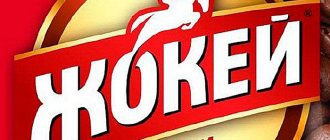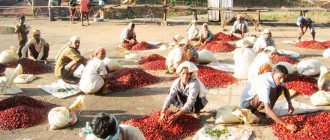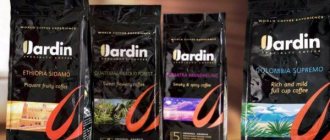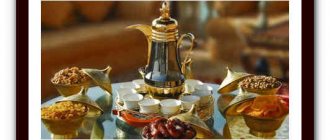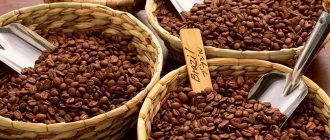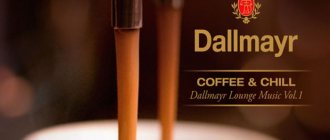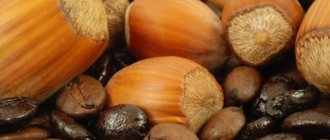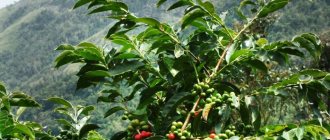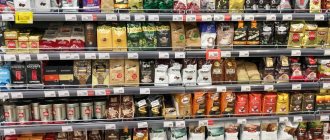All connoisseurs of the invigorating drink are divided into two types. Some rush to the kitchen to brew an instant mixture in boiling water. And others make a whole ritual out of preparation, constantly experimenting with the brewing method and varieties, including Mexican coffee.
Despite the fact that it is not so popular in our country, true connoisseurs cannot resist its enchanting aroma and taste.
Brief history of origin
Spanish colonists brought the first coffee trees to the state in the 18th century. They began to be planted in the state of Veracruz. True, initially the seedlings did not take root well. Farmers had to put in a lot of work to develop this crop throughout the country.
Towards the end of the 19th century, the redistribution of territories began in the state. Europeans began to buy up huge areas. They decided to develop the coffee industry. Thanks to this, coffee from Mexico began to be supplied to the world market. The country is among the top ten exporters of this product.
Coffee in cezve “Halva”
Anna Brovkina, chef barista of the Kazbek restaurant, shares with us.
.
Photo courtesy of the Kazbek restaurant
Ingredients:
- Ground coffee 40 g
- Water 280 ml
- Suluguni cheese 30 g
- Almond milk 40 g
- Handmade halva 100 g
How to cook:
First you need to prepare the halva sauce. Halva should be broken into small pieces, poured with almond milk, placed on the stove and simmered over low heat for about 25-30 minutes. When the sauce is ready, you need to grind the coffee, add water and add 60 ml of halva sauce, you can add more if desired. Bring almost to a boil, but still do not let it boil.
This coffee should be served with slices of Suluguni cheese. It is better to take the cheese out of the refrigerator in advance so that it comes to room temperature - only then will you be able to fully enjoy its rich, creamy, salty taste in combination with hot and unusual coffee with halva.
Production Features
The state's climate is ideal for growing coffee trees. Temperature differences here are relatively small, and the rainy seasons are short. Accordingly, there is a moderate amount of precipitation.
In total, at least 400 hectares of land are occupied by plantations in Mexico. The annual harvest reaches 300 thousand tons. As a rule, only medium and small entrepreneurs are involved in coffee production. There are few large enterprises in the coffee industry.
An area at an altitude of 400 to 900 meters was selected for growing trees. The Arabica that grows on them is called lowland. As a rule, plantations are located on volcanic soil. The taste of the resulting product is influenced by the region of origin.
The grains are processed using the wet method - the fruits are cleared of pulp using water.
Mexico is characterized by the cultivation of only Arabica beans. Its hot but mild climate is perfect for the “capricious” variety. Vast areas of the country are occupied by coffee plantations, almost half a million hectares are given over to Arabica shrubs. Every year Mexico exports more than 300 thousand tons of grain. Varieties from this country are used in the most exquisite blends.
Mexico ranks 5th in the world in coffee sales. Manufacturing business predominates in the country. That is, small family organizations own small plots of land with Arabica bushes growing. There are no large producers of coffee beans in Mexico. But this does not prevent it from occupying a leading position in exports.
The most famous Mexican bean coffee varieties are:
- Pluma;
- Altura;
- Hai and others.
Most Mexican beans do not have a strong flavor. However, this drawback can be easily eliminated by increasing the dosage during brewing. It should be noted that high-mountain Mexican coffee is more valuable. It has a pleasant nutty aroma and contains chocolate and bread notes. Each state has its own traditions and growing characteristics.
The main Arabica resources are concentrated in the southern regions of the country. It is there that the climate is balanced. Most Mexican Arabica is lowland. Despite this, the fruits ripen well and produce grain of high culinary value. The main “coffee” states are:
- Veracruz;
- Oaxaca;
- Chiapas.
The largest part of the grains is collected in the state of Veracruz. Shrubs are planted here in the traditional Mexican way - about 1,600 plants per hectare. For comparison, on plantations in the rest of Central America there are about 5,000. As a result, Mexican grain is filled with nutrients and receives enough air and space to grow.
Oaxaca is the state that produces the Arabica variety of the same name. It is the basis of many blends beloved by Europeans. Its features include a subtle vanilla flavor and chocolate aroma.
Chiapas is famous for its temperate climate. Average temperatures here do not rise above 26 degrees, which is ideal for growing coffee. Varieties from this state are distinguished by greater tartness, fullness of taste, and a floral tint.
Mexican coffee beans are mainly used for making blends. Many leading brands in the world use it as the basis of their blends.
The best varieties
Only Arabica beans are grown in this state. The best varieties include Maragodzhip, Elephant Breeze and Tapachula. In addition, several unique local varieties should be highlighted:
- Altura is a high-quality variety that grows in highlands;
- Altura Huatusco - grown in the state of Oaxaca;
- High Coatepeque - grows in mountainous areas, near the city of Coatepeque;
- Pluma Coatepeque - grown in Oacaja, is considered one of the highest quality varieties.
Arabica varieties as a souvenir home
Mexico is famous for its large grain varieties - Maragogipe and Elephant Beans. There are elite varieties grown in the mountains, the rest belong to the middle price segment. Tourists visiting the country, in addition to souvenirs, bring home local types of alcohol - tequila and mezcal, chocolate sweets, as well as varieties of Mexican coffee collected in the south of the country.
Maragogyp
Mexican Maragojipe is grown in regions closer to Guatemala. Its taste is slightly bitter, but less harsh than its Nicaraguan counterpart. The flavor notes are dominated by chocolate and nut notes.
Zafiro
The Mexican coffee variety Zafiro is grown at an altitude of more than 1,400 m above sea level, so it can safely be called elite. Tasters compare it to dry white wine in terms of taste characteristics. Chocolate or nutty shades may predominate.
Altura
One of the most expensive varieties of coffee that can be brought from Mexico is Altura. It will appeal to lovers of weak drinks. The aroma is also not pronounced, but the taste is refined, soft, harmonious. This is one of those varieties that cools down and gets stronger.
Coatepec
This variety is represented by two varieties - Pluma and Hai Coatepec. Grown in mountainous areas. Characterized by a nutty taste. To get a rich drink, it is recommended to brew twice the dose of powder.
Video: Review of the Mexican Maragogype
Tapanchula
Tapanchula is one of the best varieties in Mexico after Maragojipe. Has a light taste. Mexican coffee is preferred by those people who do not value richness and strength and do not need a dose of caffeine in the morning. It is for the lightness of aromas and taste that grains of Mexican origin are not always appreciated by tasters.
Mexican coffee recipes
In Mexico, coffee drinks are prepared using a special technology. There is far more than one recipe that makes it possible to fully reveal the taste qualities of grains and complement them with new shades.
Classic recipe
To prepare two servings of Mexican coffee you will need the following ingredients:
- 200 ml water;
- 20 g crushed grains;
- 10 g chocolate;
- 10 g granulated cane sugar;
- a pinch of cinnamon and nutmeg;
- 20 ml whipped cream.
To get a flavorful drink you need to do the following:
- Pour the crushed grains into the Turk and add water.
- Place the container on the stove and wait for the foam to rise.
- Set the cezve aside and after the foam settles, repeat the same manipulations.
- In one container, mix cinnamon, granulated sugar and nutmeg.
- Melt the chocolate and pour into cups.
- Then pour coffee into the bowl and stir.
- Top with a mixture of cinnamon, nutmeg and granulated sugar.
- Garnish the resulting drink with whipped cream.
Invigorating Mexican coffee
During the cooking process you will need the following products:
- a teaspoon of ground beans and cocoa;
- 100 ml water;
- 20 ml condensed milk;
- 2 pieces of refined sugar.
Just a few steps are performed:
- Pour cocoa and coffee powder into the cezve.
- Add water and brew coffee.
- Pour the resulting drink into a cup.
- Add condensed milk and stir.
- Serve refined sugar separately on a plate.
Coffee drink with tequila
This recipe is especially popular among Mexicans. Thanks to its use, it is possible to obtain slightly tart, aromatic coffee with a bright taste. In this case you will need:
- 15 g ground beans;
- 150 ml water;
- 15 ml tequila;
- 30 ml liqueur;
- cinnamon stick.
There are several stages of preparation:
- Brew coffee beans using any convenient method.
- In a separate bowl, mix tequila and liqueur.
- Add the resulting mixture to a hot drink.
- Garnish with a cinnamon stick.
Local recipes
Mexicans have their own coffee recipes that come from ancient times. To add spiciness, spices are added to the finished drink - cinnamon, vanilla sticks, chili pepper. You can’t do without alcohol, for example, tequila with salt in combination with espresso.
Since cocoa beans are also grown in Mexico, many recipes are made using these two ingredients.
For example, coffee with chocolate and spices, for which you need to prepare:
- glass of espresso;
- 2 cinnamon sticks;
- 25 - 30 g of natural Mexican chocolate;
- sugar to taste – cane sugar is better;
- ground spices little by little - nutmeg, cinnamon and vanilla;
- whipped cream for decoration.
Cooking method:
- Brew espresso in a pot or pot.
- Melt the chocolate bar, mix with spices and sugar. Pour into the finished drink.
- Add vanilla and cinnamon sticks.
Place whipped cream on top.
A popular local drink is cortado. It tastes like cappuccino, but the milk is not frothed, but added to the espresso. In summer, ice is added to the drink.
"De Olla"
Traditionally it is prepared in a clay pot, but any utensil will do at home. All ingredients - coffee, cane sugar, cinnamon stick and water are mixed and the drink is brought to a boil. Next, you need to cool it for 5 minutes, then bring it to a boil again. The idea is to let the flavors of the spices and powder mix and infuse together. Then the coffee is poured into cups.
Mixed drink
If you mix ground cocoa and coffee, you can get not only an invigorating, but also a nutritious drink. It is often recommended to athletes as an energy boost between workouts. To prepare:
- Mix ground cocoa beans and coffee in equal proportions.
- Put sugar and pour water.
- Place on fire and bring to a boil.
- Add condensed milk or cream to the finished drink.
Mexicans are famous for their love of sweets, so the energy drink is also served with homemade baked goods made from sunflower seeds, seeds and flour.
How did coffee with pepper come about?
Coffee with pepper is by no means a tribute to fashion, as many might think. In addition to Ethiopia, this combination is mentioned in the preparation of the drink by Turkish housewives of the 15th-16th centuries. Along with such spices as cardamom and cloves, it was considered traditional to add a pinch of hot pepper. But in such a way as not to prepare fire water, but to literally highlight and saturate the unique coffee aroma.
Today, it’s rare that a coffee lover doesn’t have a couple of signature recipes for making coffee with pepper. Indeed, truly, this spice ennobles the aromatic drink and gives it a zest.
Vietnamese coffee
Perhaps not everyone knows that Vietnam has a stable position in the world market as a coffee-producing country. The Robusta variety is grown and cultivated there. What gives Vietnamese coffee its specificity is that the beans are roasted in duck fat. After this roasting, the coffee acquires a very strong chocolate-nutty taste and smell. It may even seem like some kind of flavorings have been added. In fact, this is not so: the thick coffee aroma is provided exclusively by the original method of roasting the beans. In Moscow, Vietnamese coffee is sold in large chain supermarkets.
For Vietnamese coffee, it is best to use the Robusto coffee variety. Or blends of Arabica and Robusto. Arabica gives fruity notes, noble sourness, and robusto gives strength and nutty-chocolate tones.
Photo: Alan Katsiev/Mir TV and Radio Broadcasting Company
Ingredients:
- Ground coffee 20 g
- Water 150 ml
- Condensed milk – 10 ml
How to cook:
This drink is actually prepared on the table, using a special filter. Such filters are sold in large supermarkets; this is now a fairly fashionable trend in the preparation of a popular drink. The filter is a metal container, the bottom of which is not solid, but has small holes. Pour the ground coffee into an even layer at the bottom, screw in the second mesh filter, which presses the coffee. The main thing is to not screw the filter too tightly so that the layer of coffee is not too compressed and allows droplets of water to pass through. Hot water, slowly seeping through the coffee, turns into an aromatic drink. The water should be about 80 degrees, not boiling water.
Before pouring water into the filter, you need to pour condensed milk into the bottom of the cup. You don’t have to do this if you don’t like sweet coffee, but this is how this drink is prepared in the classic version. Now pour hot water into the filter with ground coffee. Nothing happens for a few seconds, then the coffee begins to drip, passing through the filter and a layer of ground coffee. Gradually he fills the cup. The coffee takes about 8 minutes to prepare and has time to become warm rather than hot. In Vietnam, it is customary to serve this coffee with ice, but in the Russian winter this is not at all necessary. Try it, this coffee is very tasty, unusual and effective in preparation. How great it is to play this while receiving guests! It turns out to be a whole coffee ceremony.
Growing regions
Population: 118,395,000
Number of bags (60 kg): 3,900,000
Coffee is also grown outside the regions indicated below; there is no need to refuse a product if a roaster or seller you trust offers such beans. It's just that production in these regions is significantly inferior to the main coffee areas.
Chiapas
The region borders Guatemala. The Sierra Madre mountain range, as well as fertile volcanic soils, provide the necessary altitude for coffee trees to grow.
Height: 1000-1750 m
Harvest: November - March
Varieties and varieties: Bourbon, Tupica, Caturra, Maragogype
Oaxaca
The area of most farms does not exceed 2 hectares, and there are several large cooperatives in the region. There are also several large plantations here, some of which offer excursions for tourists.
Height: 900-1700 m
Harvest: December - March
Varieties and varieties: Bourbon, Tupica, Caturra, Maragogype
Filters
Monin syrup HomeBar SodaStream syrup Coffee syrups, Order coffee syrup. For Soda Syrups Sweetfill. Order SvetFill syrups. Monin-Keddy Barinoff syrup Spoom syrup Philibert Routin 1883 syrups Vedrenne syrups Teisseire syrup Walden Farms Egibel syrups HomeBar LaPlaya Aladdin Thermos Stanley Syrups for lemonade Syrups for cocktails Syrups for tea Syrups for milkshakes Exchange cylinders SodaStream, HomeBar, Linde Syrups 50, 250 , 500 ml. All up to 300r. All Russian syrups Promotion Easter 2016 Coffee glasses Baresto syrups Richeza syrups Syrups 0.7 and 1 l BOTANIKA syrups an excellent choice for a coffee lover Contigo ISI Coffee Tabera Coffee Pellini Coffee Melna Coffee Black Professional Tasty Coffee GingerMe ILSA Eternum Borgonovo Royal Cane syrup. Order Royal Cane Turkey syrups for Ezetil coffee Green Lines Tea latte David Rio in St. Petersburg 70% Arabica/ 30% Robusta 60% Arabica/ 40% Robusta 80% Arabica/ 20% Robusta 100% Arabica Sale Toppings Spoom Oxygen cocktails Spoom Arabica 90 %/ Robusta 10% Arabica 85%/ Robusta 15% Arabica 75%/ Robusta 25% Arabica 50%/ Robusta 50% Arabica 30%/ Robusta 70% Arabica 20%/ Robusta 80% Decaffeinated Espresso machine Drip coffee maker Turka Geyser coffee maker Chemex French press Aeropress Pourover Robusta 100% ARC shot glasses Experienced glass factory Water glasses Pasabahce Stoelzle Bormioli Rocco Durobor Arcoroc Libbey Bormioli Luigi Rona Chef&Sommelier Tognana Bormioli Rocco – Fidenza Stolzle Schott Zwiesel Cocktail glass Pasabahce – NUDE Royal Leerdam Zwies el Beer glass Neman Crisal French press for coffee Bodum ProHotel Trendglas Yongsheng Chocolate Manufactory in Gagarinskaya Novoselka Linden Leopold Mitchell & Cooper TEMP Monin accessories BFB Toppings RoyalCane Carissimi Dolce Vita GARIBALDI Arabica 35% / Robusta 65% Italcaffe 10% Arabica / 90% Robusta Arabica 95% / Robusta 5% Lucaffe Arabica 40 %/ Robusta 60% Saeco Nimex Syrups EcoSoda Syrups Barline Coombs Family Farms HLP-2 Ghidini Tramontina TUR B-Sauce Darboven DOFZ Moka Lavazza Nemox MOSA Blues Coffee Laboratory Coffee Mr. Brown Amado grain coffee and capsules Probar Fruit puree NIKTEA Osz Neman Eclat BarBook Fruit puree Vintage Inexpensive syrups less than 1 liter. Syrups Barline Maple syrup for coffee Maple syrup for cooks Maple syrup for cocktails New Year Publishing house "Eksmo" LLC Igloo Libbey Europe Royal forest Grain 1 kg Leopold Vienna TopFlavors Natural Alcoholic Identical to natural On propylene glycol (E1520) On triacetin (E1518) On vegetable oil Fat-soluble Water-soluble Gedonia STEK KunstWerk Lubiana Monin Spoom Barline Discounts on syrups BOTANIKA Sale Spoom Sale Vintage EcoSoda Coffee machine HiBest New Year's gifts Tchibo APS Syrups in large containers O!range ProffSyrup Promotion 1+1=3. Topping as a gift GiffarD Ground grain 250 gr. Bean coffee 250 gr. Flavored coffee 250 gr. Paulig Paderno URNEX BRANDS, INC. Tea Tasty Coffee Syrup HERBARISTA Ruiyuan
